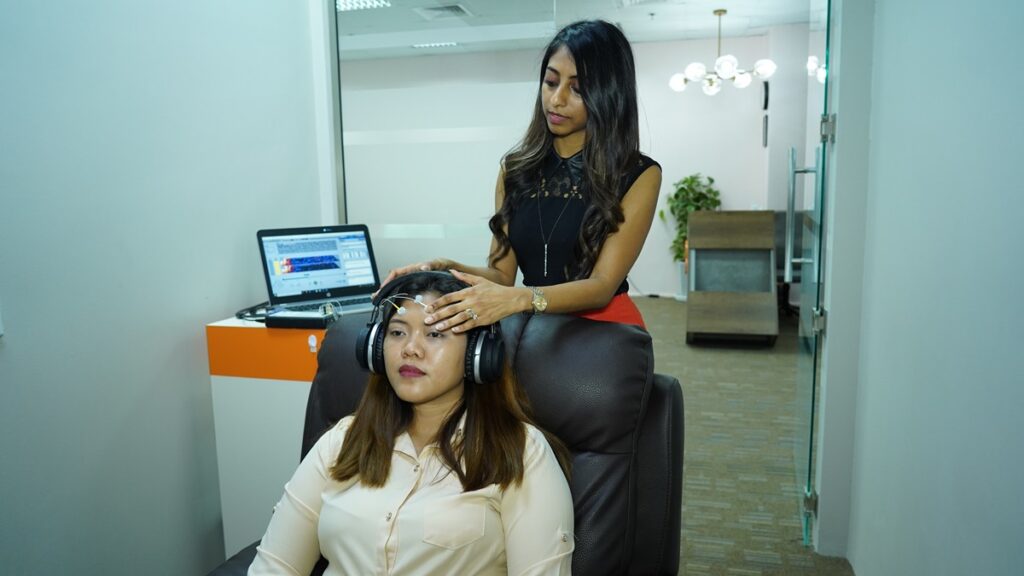Evolve Brain Training: Boost Your Brain | Brain Training Dubai
Neurofeedback for Autism
Non-Invasive Brain Training: Autism Therapy in Dubai
Autism Spectrum Disorder (ASD) is a developmental disorder that affects how behavior, language or cognitive abilities develop during childhood. Individuals with autism can experience a variety of possible symptoms, including difficulties with communication, social interactions or in performing everyday tasks.
Drawing on our experience in neurofeedback for autism treatment in Dubai, we understand that autism spectrum disorder (ASD) symptoms in children can manifest as early as two to eight years of age. Children with ASD are often rigid and sometimes, even obsessive in their behaviors and interests.
As a learning disability, ASD can also impact a person’s ability to learn basic skills such as reading and writing, math and higher skills such as abstract reasoning, planning and organization. Brain mapping as an autism treatment can help children and this form of brain training is preferred by parents for its non-invasive approach.
Know More with a Free Consultation
Did You Know?
Common Traits Across the Autism Spectrum*
- Differences in interacting with others
- Delayed speech development
- Repetitive behaviors (arm flapping, rocking, repeating words)
- Strong need for routine
- Intense focus on specific interests
- Sensitivity to sensory input (e.g., dislike of loud noises)
How Does Brain Training Help Children With Learning Disabilities?
Your child’s current difficulty in grasping basic skills does not mean they do not have the ability to learn. Telling your child to concentrate on studies can be very challenging if your child suffers from a learning disability like ASD. They may have difficulties with communication, interactions, and executive function that affect their concentration.
Neurofeedback for autism can help children learn to focus and concentrate better. With this form of brain training for autism, non-invasive EEG electrodes will be used to read and monitor your child’s brain wave activity from various points on their scalp.
All of your child’s neurofeedback for autism sessions will involve them sitting on a calming couch and watching a Netflix or YouTube video of their choice. Using data from the EEG electrodes, the screen and audio quality will keep fluctuating depending on the activity that your child’s brain exhibits.
Whenever your child promotes the right brain activity, the audio and video inputs become better. This mode works as a positive reward for your child’s healthy brainwave activity. After a few sessions, you will be able to see positive improvements in your child’s attention span and ability to learn.

Gain valuable insights into your child's development and explore their individual needs.
Book a free 15-minute consultation with our Dubai neurofeedback therapy clinic and have your child assessed today.
Testimonials
Evolve has a wonderful team of people who care and listen carefully to your needs. Dr.Upasana is highly professional and takes note of every detail. Every session is tailored to suit your requirements. My son who had mild development delays is now more confident and is able to sustain more meaningful conversations with others. He is now more aware about his own emotions and is beginning to handle them better. Sincerely thank to the whole team.

S.R.
I first heard about Evolve through my trainer and I thought of giving it a try because I was having issues with anxiety, procrastination and was even struggling to focus and concentrate on my career. After 20 sessions of brain training, I have to say that I feel like a completely new person. I don’t procrastinate any longer, I am more confident, I can see a reduction in my anxiety and I’m able to focus better on my career. I feel that the world just opened for me.

A.K.
How It Works
Initial consultation
We will discuss your specific needs and goals during consultation.
Neuropsychosocial assessment
We will do an in-depth assessment to understand your brain’s current strengths and weaknesses
Personalized training plan
Get a customized plan tailored to your specific needs.
Neurofeedback training
We begin your neurofeedback training sessions to help sharpen your brain.
Final assessment
We will repeat the neuropsychosocial assessment to track your progress.
Book Your Free 15-Minute Consultation
Let us help you make mental health a priority. Get a free, no-strings attached session to get started.
Learn More About Neurofeedback
Sitaram R. et al. (2017).
Wigton N. & Krigbaum G. (2015).
Ros T. et al. (2014).
Ghaziri J. et al. (2013).
Coenan A. et al. (2009).
Yue Hou,Shuqin Zhang,Ning Li,Zhaoyang Huang,Li Wang,Yuping Wang (2021).
Dreis, Stephanie & Gouger, Angela & Perez, Edward & Russo, G. & Fitzsimmons, Michael & Jones, Mark. (2015).
Kerson, C., Sherman, R. A., & Kozlowski, G. P. (2009).
Hammond, D.. (2005).
Hammond, D.. (2005).
Thomas, J.E., & Sattlberger, E. (2007).
Kosari Z, Dadashi M, Maghbouli M, Mostafavi H.(2019).
Dobrushina, O., Arina, G., Osina, E., & Aziatskaya, G. (2017).
Walker JE. (2011).
Perez-Elvira, Ruben & Carrobles, José & Bote, Diego & Oltra-Cucarella, Javier. (2019).
Kosari Z, Dadashi M, Maghbouli M, Mostafavi H. (2019).
Frequently Asked Questions on Autism Spectrum Treatment
Does autism get better with age?
What foods can help autism?
Most experts agree that there are no specific foods that can cure autism and that there is little evidence that diet can improve ASD symptoms.
There are no differences in nutritional needs for people with ASD either. Getting a healthy, balanced diet is important for every child, including those with ASD.
However, children with ASD can experience sensory difficulties and this can impact the foods that they are willing to eat. It is common for children with ASD to have a strong preference or dislike for certain foods, to insist their food is cut or prepared in a certain way or to not want foods to touch on their plate. This can make mealtimes stressful. If you are worried that your child is not getting a balanced diet from the foods they eat, it is important to seek advice from a nutritionist.
Can autism get better with therapy?
Many children and adults with ASD benefit from therapies that improve their symptoms. Targeted therapies are available that can help people manage their symptoms and improve their everyday lives in areas such as communication and speech, occupational therapy and school-based therapies.
Neurofeedback for autism is an example of a documented therapy that helps your child’s ability to focus and concentrate.
What helps calm down autism?
Strategies to help children with autism stay calm include sensory and fidget toys, mindfulness practices, calming games and physical exercise like yoga. Each child will respond differently to these ideas but, over time, you can develop a toolkit of strategies that help your child when they feel overwhelmed.
It is very common for children with ASD to become especially anxious or have a meltdown. Therefore, it is important to recognize the signs of overwhelm and overload early so that you can introduce the tools that work well for your child as soon as possible. Signs of overwhelm include sensory avoidance, such as closing eyes or putting hands over their ears, an increase in stimming behaviors like hand flapping and rocking, or attempting to run away.
What are the 6 stages of autism meltdown?
For children with autism, meltdowns are intense and involuntary responses to overstimulation or overwhelming experiences. Some experts believe autism-related meltdowns often involve six stages: pre-meltdown calm, the first experience of triggers, increasing agitation, meltdown, re-grouping, and finally starting over.
Understanding the patterns of meltdowns can help parents intervene by removing triggers or by removing their child from the situation.
What triggers autism meltdowns?
Autism meltdowns can be triggered by a huge variety of situations, including sensory overload such as very bright lights, loud noises and strong smells. Other triggers could include changes to everyday routines and environments.
Children with ASD can become frustrated with their ability to communicate their needs, feel more anxious about upcoming events or situations, or become exhausted from trying to mask their symptoms. All these issues can also lead to meltdowns.
How close are we to a cure for autism?
We are not yet close to a cure for autism. This is because it is a complex condition with no single known cause. Many researchers are currently trying to untangle the links between genetics and ASD in the hope that we will better understand the condition and the potential for treatment.
We are getting better at providing treatment to improve the symptoms of autism and improve the quality of life of those with ASD. Neurofeedback for autism is an example of a treatment that has demonstrated the potential to help children with ASD by improving cognitive function and concentration skill.
Ask us your question about neurofeedback today. We’re here to help.
Technology Used By










